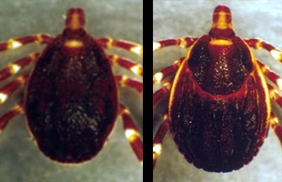 Ticks are the main vector of CCHFKabul 7 September 2016 – Health and livestock authorities are concerned about the spread of a serious tick-borne viral disease called the Crimean-Congo haemorrhagic fever (CCHF) in Afghanistan. The Ministry of Public Health, Ministry of Agriculture, Irrigation and Livestock, World Health Organization (WHO) and the Food and Agriculture Organization of the United Nations (FAO) are urging the public to take special preventive measures to protect themselves from the disease.
Ticks are the main vector of CCHFKabul 7 September 2016 – Health and livestock authorities are concerned about the spread of a serious tick-borne viral disease called the Crimean-Congo haemorrhagic fever (CCHF) in Afghanistan. The Ministry of Public Health, Ministry of Agriculture, Irrigation and Livestock, World Health Organization (WHO) and the Food and Agriculture Organization of the United Nations (FAO) are urging the public to take special preventive measures to protect themselves from the disease.
The CCHF viral disease is primarily transmitted to people from ticks or through contact with infected animal blood or tissues during and immediately after slaughter. During Eid-al-Adha many people will be slaughtering animals and the risk of CCHF virus transmission is expected to increase. The hosts of the CCHF virus include a wide range of wild and domestic animals such as cattle, sheep and goats. Human-to-human transmission can also occur resulting from close contact with the blood, secretions, organs or other body fluids of infected persons.
“CCHF is a serious health issue in Afghanistan with a fatality rate currently of around 12%. So far this year 66 cases have been confirmed and 12 people have already lost their lives to this disease and the risk further increases during the upcoming Eid holiday,” said H.E. Dr Ferozuddin Feroz, Minister of Public Health. “We urge everyone to take necessary preventive measures as they slaughter animals during the holy Eid-al-Adha holiday to protect themselves and their families from this virus.”
“It is important that people wear gloves and other protective clothing when handling animals and their tissues. To prevent tick-to-human transmission, people should wear protective and light-coloured clothing to be able to detect ticks more easily,” said H.E. Assadullah Zamir, Minister of Agriculture, Irrigation and Livestock. “CCHF is a serious, deadly disease but by taking the appropriate precautions we can minimize the risks.”
People most at risk of contracting CCHF include animal herders, livestock workers, butchers, slaughterhouse workers and veterinarians. Health care workers are also at risk of infection through unprotected contact with infectious blood and body fluids while caring for patients. There is no vaccine available for either people or animals which means prevention is crucial.
The symptoms for CCHF include fever, muscle ache, dizziness, neck pain and stiffness, backache, headache, sore eyes and sensitivity to light. There may be nausea, vomiting, diarrhoea, abdominal pain and sore throat early on, followed by sharp mood swings. If CCHF infection is suspected, the person should visit the nearest health centre.
“WHO is supporting enhanced surveillance through the Ministry of Public Health by further scaling up surveillance activities and laboratory capacity. Health care providers are being trained to be able to diagnose and treat people with CCHF and spread the right messages about the disease. We urge the public to remain extra vigilant and protect themselves as they celebrate the Eid holidays with their loved ones,” said Dr Richard Peeperkorn, WHO Country Representative.
“FAO is fully engaged in supporting this important preventive initiative and additional steps have been taken to strengthen veterinary laboratory capacity and enhance awareness of people involved in the livestock sector. Globally, 75% of infectious diseases that have affected humans in the past 10 years have been caused by pathogens originating from animals or from products of animal origin, CCHF being among those. Well-coordinated efforts must continue beyond the upcoming holy Eid-al-Adha,” said Mr Tomio Shichiri, FAO Representative in Afghanistan.
Related link
Crimean-Congo haemorrhagic fever


